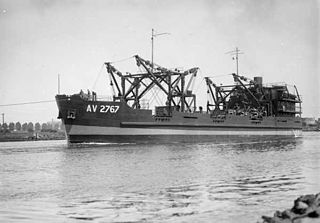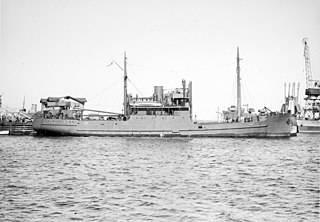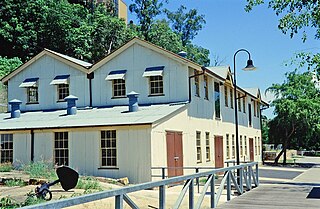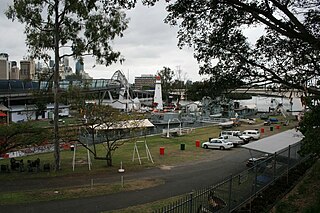
The Cockatoo Island Dockyard was a major dockyard in Sydney, Australia, based on Cockatoo Island. The dockyard was established in 1857 to maintain Royal Navy warships. It later built and repaired military and battle ships, and played a key role in sustaining the Royal Australian Navy. The dockyard was closed in 1991, and its remnants are heritage listed as the Cockatoo Island Industrial Conservation Area.

Fleet Base East is a Royal Australian Navy (RAN) major fleet base that comprises several naval establishments and facilities clustered around Sydney Harbour, centred on HMAS Kuttabul. Fleet Base East extends beyond the borders of Kuttabul and includes the commercially-operated dockyard at Garden Island, and adjacent wharf facilities at nearby Woolloomooloo, east of the Sydney central business district in New South Wales, Australia. Fleet Base East is one of two major facilities of the RAN, the other facility being Fleet Base West. The fleet operates in the Pacific Ocean.

City of Adelaide is a clipper ship, built in Sunderland, England, and launched on 7 May 1864. It was built by Pile, Hay and Co. to transport passengers and goods between Britain and Australia. Between 1864 and 1887 she made 23 annual return voyages from London and Plymouth to Adelaide, South Australia and played an important part in the immigration of Australia. On the return voyages she carried passengers, wool, and copper from Adelaide and Port Augusta to London. From 1869 to 1885 she was part of Harrold Brothers' "Adelaide Line" of clippers.

The former Melbourne Maritime Museum, now, the Polly Woodside tall ship and museum, managed by the National Trust of Australia, is situated in South Wharf on the Yarra River in the city of Melbourne, Victoria, Australia.
The Queensland Maritime Museum is located on the southern bank of the Brisbane River just south of the South Bank Parklands and Queensland Cultural Centre precinct of Brisbane, and close to the Goodwill Bridge.

HMAS Diamantina (K377/F377/A266/GOR266), named after the Diamantina River in Queensland, is a River-class frigate that served the Royal Australian Navy (RAN). Constructed in the mid-1940s, Diamantina was active from 1945 until 1946, was placed in reserve, then was recommissioned as a survey ship from 1959 until 1980.

SS John Oxley is a steamship that previously served as a pilot boat and lighthouse and buoy tender. The ship was built in Scotland in 1927 for the Queensland Government. The vessel was requisitioned by Royal Australian Navy during the World War II. Returned to her duties after the war, John Oxley remained active until 1968, when her deteriorating condition made her unusable. In 1970, the ship was donated by the Queensland Government to the Lady Hopetoun and Port Jackson Marine Steam Museum for preservation, but due to other projects, work was sidelined until 2004. The ship has undergone restoration for the past 20 years at Rozelle Bay on a floating dock. In April 2022, she was towed to dry dock at Garden Island, re-floated successfully and returned to Rozelle Bay for further restoration work afloat.

Walkers Limited was an Australian engineering company, based in Maryborough, Queensland. It built ships and railway locomotives. The Walkers factory still produces railway locomotives and rolling stock as part of Downer Rail.

HMAS Gladstone (J324/M324), named for the city of Gladstone, Queensland, was one of 60 Bathurst class corvettes constructed during World War II, and one of 36 that were initially manned and commissioned solely by the Royal Australian Navy (RAN). Built by Walkers Limited, the ship was commissioned in 1943.

Mort's Dock is a former dry dock, slipway, and shipyard in Balmain, New South Wales, Australia. It was the first dry dock in Australia, opening for business in 1855 and closing more than a century later in 1959. The site is now parkland.

Forceful is a sea-going tugboat built for the Queensland Tug Company by Alexander Stephen and Sons Ltd in Govan, Scotland in 1925. She worked at her homeport of Brisbane, Australia between 1926 and 1970 berthing ships and assisting nearby casualties. During World War II she was commissioned into the Royal Australian Navy in early 1942 as HMAS Forceful (W126), based at Fremantle and Darwin, until returning to commercial service in October 1943. She is preserved as a museum ship at Brisbane.

Crusader (AV2767) was an Australian Army amphibious operations support ship of World War II. She was launched shortly before the war ended and entered service in late 1935. From 1945 to 1947 she was mainly used to return Australian Army equipment from the islands off New Guinea. She was also loaned to the Australian Shipping Board in early 1947 and transported earth moving equipment and timber between Melbourne and Tasmania. However, the Army did not need a ship with Crusader's capabilities after the war, and she was sold in 1947 to the Queensland Cement and Lime Company which operated her as a coral barge on the Brisbane River until the mid-1980s. The ship was scuttled in 1986 and became a popular dive wreck.

Cumbooquepa is a heritage-listed house at Somerville House, 253 Vulture Street, South Brisbane, City of Brisbane, Queensland, Australia. It was designed by George Henry Male Addison and built in 1890. It is also known as Brisbane High School for Girls. It was added to the Queensland Heritage Register on 21 October 1992.

HMAS Bingera was an auxiliary anti-submarine vessel of the Royal Australian Navy (RAN) during the Second World War. Bingera was built by William Denny and Brothers, Dumbarton in 1935 for the Australasian United Steam Navigation Company for the Queensland coastal trade, arriving at Brisbane on 18 November 1935.

South Brisbane Library is a heritage-listed former library at 472 Stanley Street, South Brisbane, City of Brisbane, Queensland, Australia. It was designed by Francis Drummond Greville Stanley and built from 1881 to 1902 by W Macfarlane. It is also known as South Brisbane School of Arts, South Brisbane Mechanics Institute, South Brisbane Technical College, and South Brisbane Post & Telegraph Office. It was added to the Queensland Heritage Register on 21 October 1992. It now houses the Griffith University Film School, which forms part of the Queensland College of Art.

Naval Stores is a heritage-listed storehouse at 34 Amesbury Street, Kangaroo Point, Queensland, Australia. It was built from 1886 to 1900s. It is also known as Naval Brigade Stores and Naval Depot. It was added to the Queensland Heritage Register on 21 October 1992.

The South Brisbane Railway Easement is the heritage-listed remnants of a former railway branch line and siding at 412 Stanley Street, South Brisbane, Queensland, Australia. It was built from 1882 to 1897. It is also known as Dry Dock Siding, South Brisbane Wharves Extension, and Stanley Street Terminus. It was added to the Queensland Heritage Register on 21 October 1992.

The former Dispenser's House of Diamantina Hospital is now the heritage-listed Diamantina Health Care Museum at Cornwall Street, Woolloongabba, City of Brisbane, Queensland, Australia. It was designed by Thomas Pye of the Queensland Government Architect's Office and built in 1908 by W Chaplain. It was added to the Queensland Heritage Register on 3 July 2007.

Naval Offices is a heritage-listed office building at 3 Edward Street, Brisbane City, City of Brisbane, Queensland, Australia. It was designed by Department of Public Works and built from 1900 to 1901 by J Mason. It was added to the Queensland Heritage Register on 21 March 2013.

The Cairncross Dockyard was a shipyard beside the Brisbane River at 405 Thynne Road, Morningside, City of Brisbane, Queensland, Australia. It included one of Australia's largest graving docks with an 8.5 metre deep water access, capable of taking Panamax vessels of up to 85,000 dwt, up to 263 metres long x 33.5 metres wide. It is second in size only to the Royal Australian Navy's Captain Cook Graving Dock in Sydney.
























